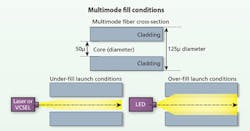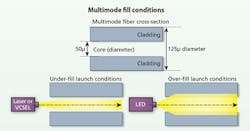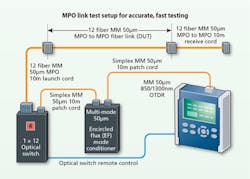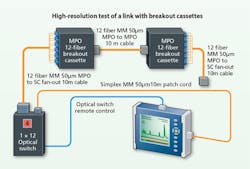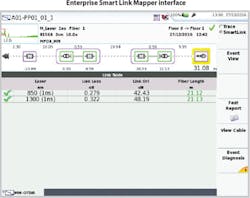By Charlene Roux, Viavi Solutions; Tim Yount, Fiber Insight LLC
As the volume of fibers deployed into enterprise increases significantly, fiber cabling advances like multifiber (MPO) connectors and interfaces between simplex, duplex and MPOs have evolved to reduce space and speed installations. The importance of proper testing to effectively qualify and troubleshoot these more-complex links has also increased due to higher data rates in both singlemode and multimode fiber environments.
These more-stringent requirements create challenges to simplify testing for technicians, while also increasing testing efficiency and accuracy. Multimode deployments are even more challenging than singlemode due to the higher test inaccuracies that occur due to optical launch conditions (proper filling of the fiber core during testing).
As network speeds continue to increase, so does the importance of ensuring pristine endface conditions. While inspection is not specifically covered in this article, proper implementation of inspection and cleaning techniques for all connector endfaces plays an equally important role and is a prerequisite for successful execution of all topics discussed herein.
Test improvement challenges
Today’s most significant test challenges for Tier 2 in enterprise and data center fiber deployments can be summarized as follows: assessing multimode fiber links accurately; reducing test time for multifiber connectors; enabling Tier 2 testing by technicians of any skill level; facilitating effective troubleshooting of MPO breakout cassettes. Let’s look at each of these challenges in more detail.
Accurate assessment of multimode fiber links - Incremental improvements have been achieved over the years, but this challenge has been ongoing since the beginning of multimode deployments in the early 1980s. The challenge is based on the fact that achieving proper multimode fill conditions has always been difficult. Proper fill conditions refer to the transmitted light fully filling, but not overfilling the fiber core. Testing fibers with underfilled launch conditions understates loss values, while overfill conditions overstate losses.
Since 2012 encircled flux (EF) has been implemented as a more-accurate standard method to establish optimal modal launch fill in multimode fibers. This enables testing to assess more accurate loss values of fiber links. It is also the only method that can facilitate repeatable and reliable insertion-loss values for fiber events (splices, connectors, bends) with an optical time-domain reflectometer (OTDR).
However, EF adoption brings its own set of challenges, namely additional complexity and thus lack of practical use in actual deployments. To meet EF standards with most testers today (optical loss test sets and OTDR), an external EF mode conditioner must be placed in line between the test transmitter and the fiber under test. In the case of insertion-loss testing, referencing has to be performed with the external mode conditioner as part of the referenced testing device.
Reduction in test time for multifiber interconnects - With substantial increases of fiber counts and in the cables interconnecting them, MPO multifiber interconnects have become the de-facto industry standard in high-speed data centers. The ability to test each MPO fiber link has historically been performed manually using fanout cables. These are cables having simplex connections on one end and an MPO multifiber connection at the other end.
The tester accesses each of the simplex fibers one-by-one to test each fiber link, which means in a 12-fiber MPO environment, each fiber must wait its turn to be connected to the test port. Manual testing translates to times of typically 40 minutes per 12-fiber MPO link. While this may be manageable if making a small number of tests, when testing high numbers of MPO fiber links the time required becomes significant. For instance, testing a rack of 48, 12-fiber MPOs could take a total of 32 hours. 48 MPOs x 40 minutes/MPO = 1920 minutes = 32 hours.
Enabling Tier 2 testing by technicians of any skill level - Interpreting OTDR results can be daunting even for experienced users, and it is especially challenging for those with limited training and experience. Having the ability to setup, test, assess, and document the results is important. Approximately 50 percent of all OTDR measurement errors are due to incorrect settings for measurement range, wavelength, pulse width, display resolution, and average time; or improper trace interpretation.
The challenge has been to automate most test configurations and simplify the presentation of results to enable effective use by practically any technician regardless of experience level.
Facilitating effective troubleshooting of MPO breakout cables - Simplex and duplex connections are still predominantly used on transmission and receiver equipment that requires a conversion from MPO to individual breakout simplex or duplex connectors. The most common method used today is to employ an MPO breakout cassette. In this setup, a “cassette” is equipped with a multifiber MPO-style connector on one side, while on the other side of the cassette simplex connectors are placed with individual fibers connecting them inside the cassette with a predefined polarity order.
These cassettes can be problematic due to 1) the number of connectors in each cassette, and 2) the short length of the fiber inside the cassette between optical connections. In order to isolate an issue in the cassette to a specific connector, a higher-resolution OTDR with a very short attenuation dead zone (approximately 1 meter) is needed.
Solving challenges individually and together
Recently some innovations have been made to Tier 2 test equipment that address the challenges outlined above and, by doing so, improve fiber deployments. Please be aware that the technologies and methods described here cannot necessarily be implemented with all OTDRs from all manufacturers. The descriptive information that follows is based on products available from Viavi Solutions.
Accurate assessment of multimode fiber links - Technicians can insert an EF mode-conditioner device during testing between the OTDR (or other test source) and the fiber under test. This device conditions the launch signal for EF compliance before the test signal enters the fiber under test. When paired with an external mode conditioner, certain OTDRs can allow any 50-micron multimode test source to provide testing results that comply with EF standards.
Alternatively, some OTDRs are available with integrated modules that provide EF compliance. Using an OTDR with such a module eliminates the need for an external EF mode conditioner, which simplifies implementation by test technicians and ensures improvements in loss accuracies that EF compliance provides.
Reduction in test time for multifiber interconnects - 1x12-fiber MPO optical switches may be used as accessories for some OTDRs. A switch is placed inline between the OTDR and the MPO test access point for the link. Specifically, the OTDR module is connected to the simplex side of the switch via a 50-micron patch cord. The MPO side of the switch is connected to the MPO test access port via an MPO-to-MPO 10-meter patch cord. The optical switch is easily controlled by the OTDR via micro-USB connection.
Actual test results show that implementing an optical switch inline can cut testing time by more than half. Another benefit is less wear on test cords by a factor of 12 (assuming a 12-fiber MPO) as it eliminates repeat connections during testing
Enable Tier 2 testing by technicians of any skill level - An OTDR’s ability to convert results into a simple link schematic virtually eliminates the need for the technician to view an OTDR trace. A simplified link schematic, displayed by the OTDR, assesses the health of the link with a simple pass/fail indication, highlighting any fails and clearly explaining the measurement value as well as likely causes of the failure. In the case of Viavi’s Enterprise Smart Link Mapper (E-SLM), predefined setup configurations can be loaded in advance by management or engineering personnel, and instructions can be provided to field technicians for use scenarios.
Facilitating effective troubleshooting of MPO breakout cassettes - Some newest-generation high-resolution OTDRs are equipped with the performance needed to troubleshoot and verify MPO breakout cassettes.
Improving enterprise and data center test efficiencies
While each of the solutions described here individually provides key improvements in enterprise and data center testing, several of these solutions can be combined to sustain even more significant savings in time, accuracy and performance.
For example, one illustration in this article shows the combined use of an OTDR, an inline EF mode conditioner, and an optical switch to test MPO links quickly and accurately. In the illustration, launch and receive fibers are employed just before and after the link under test to enable the MPO connections to be evaluated as well.
In a more advanced integration example, an OTDR equipped with an EF-compliant module is used with the MPO optical switch. Fanout launch and receive fibers are used on both ends of the link. This combination enables both the link and the two connections inside the MPO breakout cassette to be tested. The higher resolution and better dead-zone performance, as described earlier, combined with the efficiency improvements in the optical switch, provide a best-in-class solution for even the most demanding high-speed data center applications.
The advances covered in this article bring significant procedural improvements, allowing more-effective testing of high-speed data center environments. When selectively combined, these tools can result in even higher productivity, and in some cases can lower the training hurdle to enable more-widespread usability.
Editor’s note: This article is excerpted from the similarly titled white paper available from Viavi Solutions. That paper provides more-extensive detail on some of the operations and technologies discussed here - including detail on the capabilities and uses of Viavi Solutions test equipment.
Charlene Roux is product line manager with Viavi Solutions (viavisolutions.com). Tim Yount is co-founder of Fiber Insight, LLC (fiberinsight.com).
